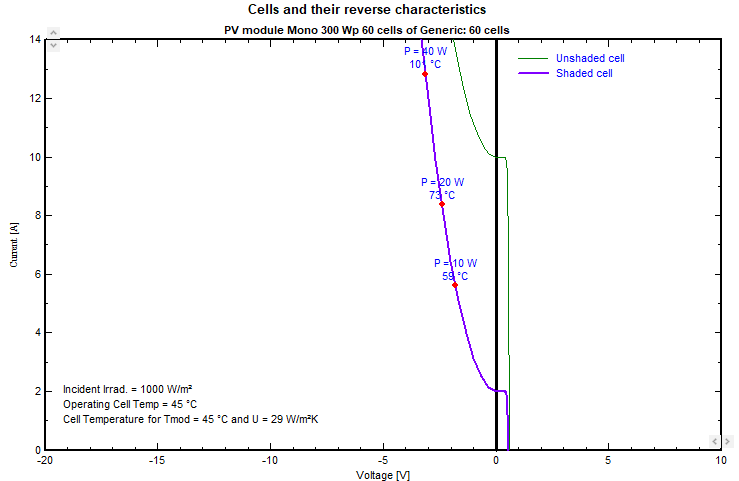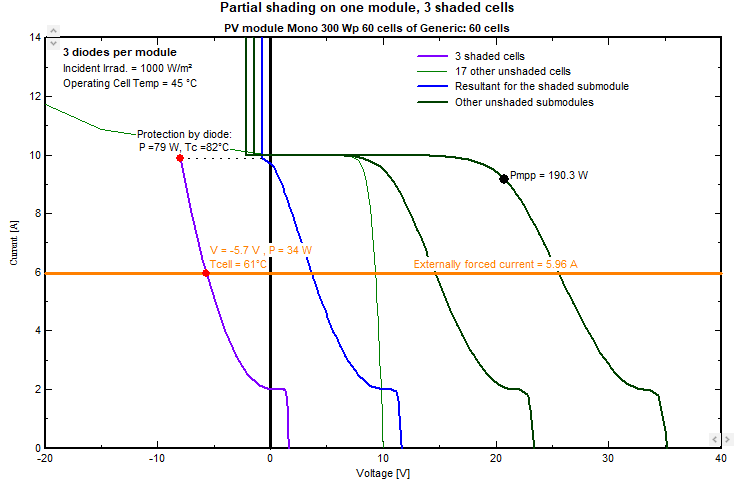PV Module reverse characteristics for IBC modules
IBC cells
In some new cell technologies (IBC - Interdigital back contact), the reverse voltage may become very low, due to the implementation of a pseudo-diode (tunnel effect) on the rear side of the PV cells. The reverse characteristics may attain 2.5V under the operating current of the module.This is often mentioned as "the cell includes its own by-pass diode". This should have consequences on the electrical shading calculation.
Implementation in the Module Layout calculation
The « Module Layout » electrical shadings loss calculation takes indeed the I/V reverse characteristics into account. For the particular behavior of these modules, we should correctly define the reverse characteristics of the cell, which is determined by the factor Arev. The model is simply Irev = Isc + Arev * Vrev². This parameter is specified in the PV module dialog, page “Additional data => Secondary parameters”. 
As an example, for getting a reverse value of 2.5 V for a current increase of 10 A, you should define ARev = 1100 mA/V². With such a value the shading calculation will use the sub-module I/V characteristics like this, that you will be able to see by opening the option “Tools => Electrical behaviour of PV arrays”, page “Array with shaded cells”, option “Cells and reverse characteristics”: 
This caracteristice will be used in all electrical shadings simulations in the ModuleLayout tool.
Effect on the electrical shadings calculation
However you cannot expect a spectacular gain with such a behaviour.
Intuitive explanation
For simplification, consider a module of 60 cells in series, i.e. a submodule of 20 cells (Vmp roughly 20 * 0.5V = 10V). If you have 1 cell shaded, at the operating current of the string (say 10A), this will loose the production of 2.5 V of reverse voltage, i.e. 2.5V / 10V If you have 2 cells shaded, this will loose 2 x 2.5 V, i.e. 5V/10V If you have 3 cells shaded, this will loose 3 x 2.5 V, i.e. 7.5V/10V, i.e only 5 cells remain active If you have 4 cells shaded, the shaded cells Voltage attains the max voltage of the submodule, you loose the whole production of this submodule. Above, the voltage of the shaded cells will exceed 10V + 0.7V, the by-pass diode will become active (i.e. derive the current). NB: Shading on one only cell is a very special situation, which is quite marginal. Shading 2 cells per submodule arises when you have shades on the bottom cells of modules in portrait.
Visualization
You can visualize this on the previously mentioned tool, option “One shaded module”. If you choose the module “Generic – PV module Mono 300 Wp – 60 cells” On the page “Cells and reverse characteristics", you define Arev, mean value” = 1100 V (i.e. Vrev = -2.5V under 10 A) You define 3 by-pass diodes and 3 shaded cells, You will obtain the following plot, where you see that the shaded submodule’s contribution (blue curve) is quasi-null at Impp. You can try with 4 shaded cells, the by-pass diode will be activated, the module behaves as any other usual module. 